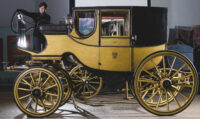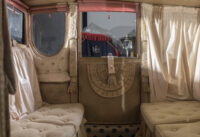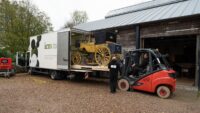 The descendant of coachman Thomas Pedler has donated the carriage his great-grandfather drove in the Victorian era to the National Trust Carriage Museum at Arlington Court in Devonshire. The carriage belonged to Robert Chichester, cousin of Colonel John Chichester who built the current Arlington Court in the 1820s, so the donation still keeps this glorious conveyance in the family.
The descendant of coachman Thomas Pedler has donated the carriage his great-grandfather drove in the Victorian era to the National Trust Carriage Museum at Arlington Court in Devonshire. The carriage belonged to Robert Chichester, cousin of Colonel John Chichester who built the current Arlington Court in the 1820s, so the donation still keeps this glorious conveyance in the family.
The museum in the stables of Arlington Court houses more than 40 carriages from a range of backgrounds and purposes, including the gilded Speaker’s State Coach, a glass hearse, an entirely utilitarian servant’s cart and private luxury coaches like this one. The collection began in 1964 with a donation of eight carriages from the Marquess of Bute. The National Trust set them up in the Victorian stable block of Arlington Court because the stables were still present, in good condition and empty instead of having been converted to other uses (cafes, shops, public restrooms) like many of the stables under the Trust’s care. The collection grew from there, even requiring construction of an annex to fit them. This is the first carriage with any connection to the Chichester family in the museum.
 Robert Chichester and family lived in a manor named Hall near the village of Bishop’s Tawton in North Devon. The estate had been in Chichester family since the 16th century, but Robert built the current mansion between 1844 and 1847. The carriage followed. After its heyday, it was retired into one of the outbuildings where it was neglected, literally used as a chicken coop, until its rediscovery in 1996. It was sold at auction that year.
Robert Chichester and family lived in a manor named Hall near the village of Bishop’s Tawton in North Devon. The estate had been in Chichester family since the 16th century, but Robert built the current mansion between 1844 and 1847. The carriage followed. After its heyday, it was retired into one of the outbuildings where it was neglected, literally used as a chicken coop, until its rediscovery in 1996. It was sold at auction that year.
Painted a distinctive bright yellow with a black roof over the passenger compartment, the carriage still carries the crest of the Chichester family on the doors. It was originally designed as a family travelling carriage or town chariot, it was converted at a later point in the 19th century to a slightly larger and less formal carriage for regular family use.
Thomas Pedler’s great grandson, Mr Garth Pedler, acquired the carriage in 1996 when it came up for sale, because of the family connection. He had some conservation work carried out on the carriage and has since gifted it to the National Trust, who will be doing further conservation on it. […]
Joanna Cairns, National Trust registrar said: ‘The process of moving the Victorian carriage from its current home near Totnes to Arlington has been fascinating. Due to its size and age, a specialist art handling company transported the carriage to Arlington Court. Once here it was then transferred into another specialist lorry where it went through a 24-hour process of warm air treatment to kill woodworm (and any other pests). Once it had the all-clear, it was admitted into the museum to ensure no pests could affect the rest of the collection.’
 Now that it has been officially introduced to the museum, the carriage will undergo extensive analysis and conservation. Conservation of carriages is complicated because there are so many moving parts and different materials, all of which require specialized treatment. This one’s stint as a chicken coop adds a layer of difficulty, albeit not as much as you might think thanks to Garth Pedler who engaged National Trust Carriage Museum experts to conserve the carriage after he acquired it in 1996.
Now that it has been officially introduced to the museum, the carriage will undergo extensive analysis and conservation. Conservation of carriages is complicated because there are so many moving parts and different materials, all of which require specialized treatment. This one’s stint as a chicken coop adds a layer of difficulty, albeit not as much as you might think thanks to Garth Pedler who engaged National Trust Carriage Museum experts to conserve the carriage after he acquired it in 1996.
Conservators will also make a detailed study of the carriage’s construction and modification because they are significant examples of local craftsmanship with several unusual features (ie, a u-shaped window in the front quarter panels, a step and join where the lace of the front interior meets the rest of the interior). The carriage was built by Pettle of Barnstaple, a carriage-building company less than 10 miles from Arlington Court. His name is on the hub caps of the carriage wheels.
As of last month, the carriage has been put on display at Arlington Court’s National Trust Carriage Museum.